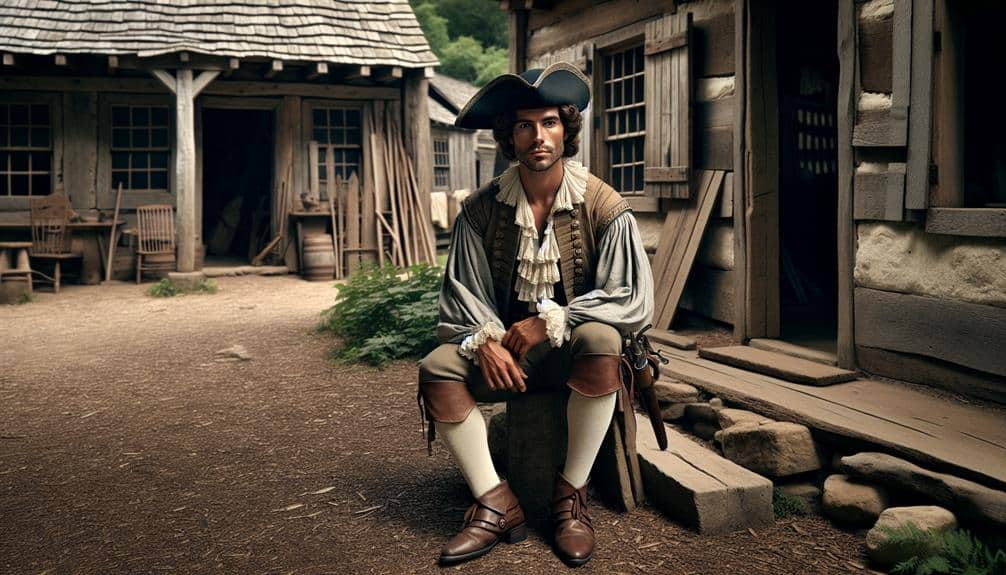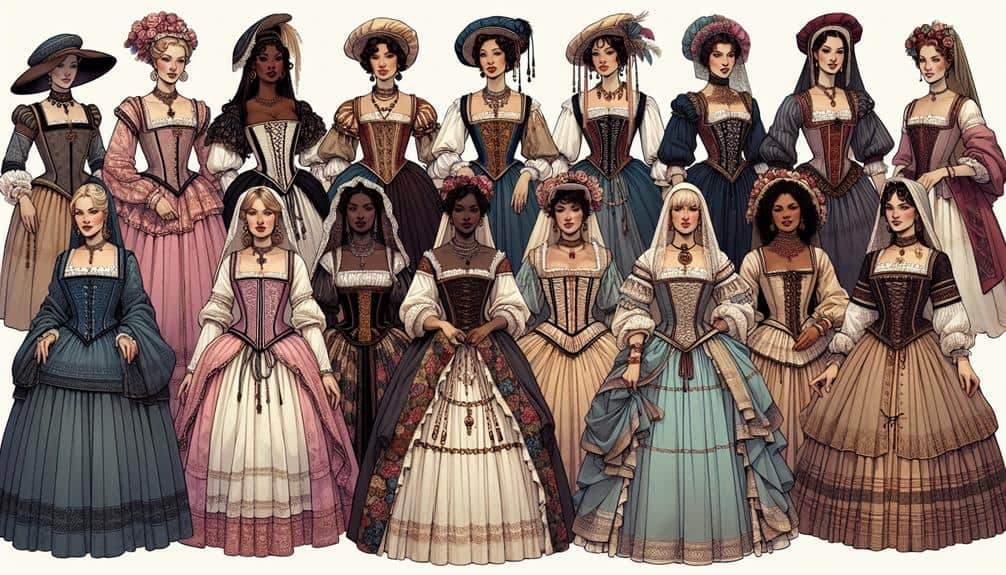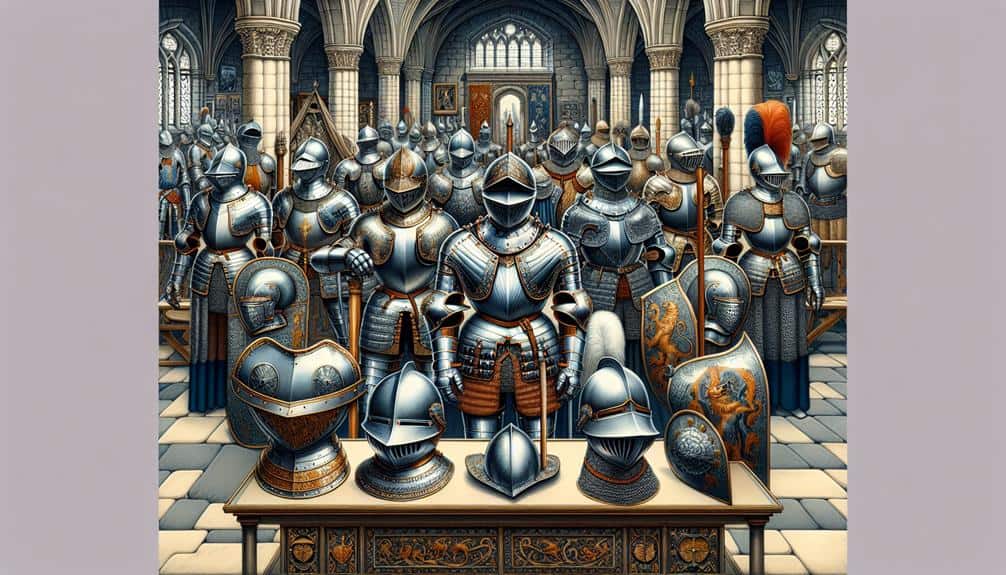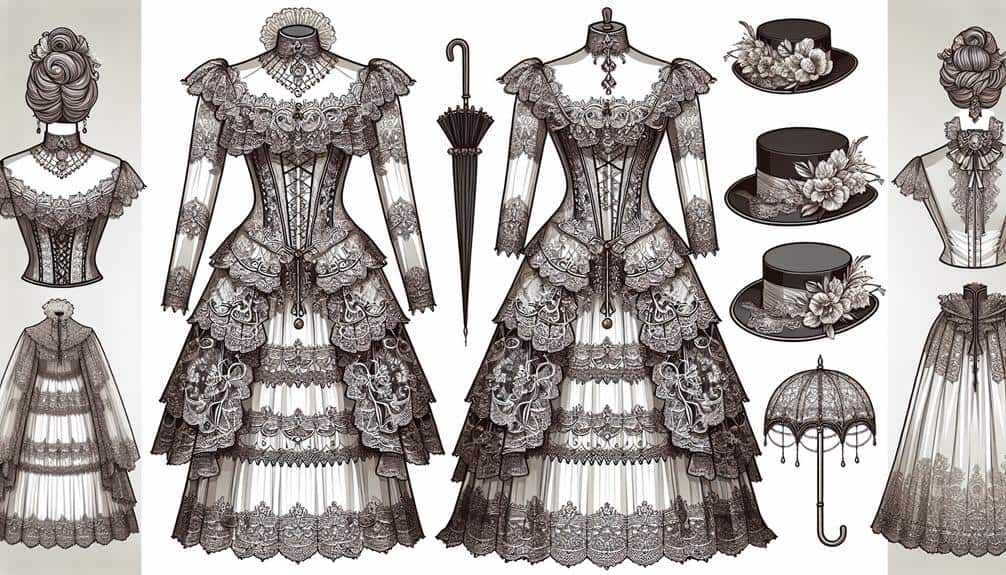When crafting Colonial America costumes for cosplay, consider the intricate details that define the era's attire. From the luscious layers of linen to the intricate embroidery, each element plays a pivotal role in embodying the essence of the period.
As you explore into the world of authentic colonial fashion, unravel the secrets behind selecting the right fabrics, colors, and accessories to truly bring your costume to life.
The journey to creating an authentic colonial ensemble is a meticulous yet rewarding process that will transport you back in time with every stitch and seam.
Key Takeaways
- Emphasize natural fabrics like linen, wool, or cotton for authenticity.
- Use earthy tones and subtle patterns for accurate colonial color schemes.
- Select appropriate accessories like buckle shoes, tricorn hats, and simple jewelry.
- Pay attention to tailoring, fit, and historical details for an authentic colonial look.
Colonial America Clothing Essentials
When creating a Colonial America costume for cosplay, it's essential to pay attention to the key clothing elements that accurately represent the fashion of that era. Historical accuracy is paramount in achieving an authentic look. For men, a tricorn hat, waistcoat, breeches, and stockings are fundamental pieces. Women should consider donning a gown with panniers, a mob cap, and heeled shoes. To stay true to the historical accuracy of Colonial America, avoid modern fabrics like polyester and opt for natural materials such as linen, wool, or cotton.
To achieve this look on a budget, consider sourcing items from thrift stores, consignment shops, or even repurposing pieces from your own wardrobe. You can also find affordable options online or at costume rental stores. For men, a simple white shirt paired with brown pants can mimic breeches, and a vest can stand in for a waistcoat. Women can create a makeshift gown by layering a skirt and blouse, and a wide ribbon can substitute for a sash. By being resourceful and creative, you can achieve a historically accurate Colonial America costume without breaking the bank.
Fabrics and Colors for Authenticity
To achieve an authentic Colonial America costume, carefully select fabrics and colors that reflect the historical accuracy of the era. When considering fabric choices, opt for natural materials like linen, wool, and cotton, which were commonly used during the colonial period. Linen was prevalent due to its breathability and suitability for warm climates, while wool provided warmth in colder regions. Cotton, although less common, was also utilized for its versatility. These fabric choices not only enhance historical accuracy but also add a touch of realism to your costume.
Authenticity is key when selecting fabric choices and color palettes for a Colonial America costume. Earthy tones such as browns, greens, blues, and grays were popular during the colonial era. Avoid bright or neon colors, as they weren't typical of the time period. Opt for muted shades and subtle patterns to stay true to historical accuracy. By carefully selecting fabrics and adhering to appropriate color palettes, you can make sure that your Colonial America costume is both authentic and visually striking.
Accessories and Footwear Selection
Have you considered the significance of accessories and footwear in completing your Colonial America costume for authenticity and accuracy? Accessories and footwear play a pivotal role in bringing your costume to life and capturing the essence of the Colonial era. When selecting accessories and footwear for your costume, it's essential to pay attention to historical accuracy and the overall aesthetic of the time period.
- Shoe Styles: Opt for footwear such as buckle shoes or Mary Janes for women and low-heeled shoes or boots for men to match the fashion of Colonial America.
- Tricorn Hat: A tricorn hat can add a touch of sophistication and elegance to your outfit, reflecting the style of the 18th century.
- Purse or Pockets: Consider adding a small purse or pockets to your ensemble for practicality and to stay true to the accessories commonly used during that time.
- Spectacles: If your character wore glasses, incorporating spectacles can enhance the authenticity of your costume.
- Jewelry: Simple and delicate jewelry pieces like pearl earrings or a locket can complement your attire without overpowering it.
Hairstyles and Headwear Tips
For an authentic Colonial America costume, carefully selecting the appropriate hairstyles and headwear is essential to accurately embodying the fashion of the time period. When considering period-appropriate hairstyles, women typically wore their hair up in elaborate styles such as curls, braids, or twisted rolls adorned with ribbons, flowers, or decorative combs. Men often sported short hair, either loose or tied back with a ribbon or a simple queue at the back. For a refined touch, women could add a cap or bonnet, while men might don a tricorn hat or a simple cap to complete their look.
Headwear styles in Colonial America varied based on social status and occasion. Women of higher standing often wore elaborate caps or bonnets made of silk or lace, while working-class women opted for simpler linen or cotton head coverings. Men of all classes favored tricorn hats for formal events, while simpler cloth caps were worn for everyday activities. To truly capture the essence of Colonial fashion, pay attention to these hairstyle and headwear details to complete your costume authentically.
Tailoring and Fit Considerations
When crafting your Colonial America costume, ensuring proper tailoring and fit is paramount to achieving an authentic representation of the fashion from that time period. To achieve historical accuracy and period-appropriate tailoring, consider the following:
- Understand Sizing Adjustments: Research how sizing was done in Colonial America and make necessary adjustments to modern sizing standards.
- Tailoring Techniques: Learn about period-appropriate tailoring methods like hand-sewing and use them for a more authentic look.
- Fabric Choices: Select fabrics commonly used during that era to make sure the costume looks genuine.
- Costume Customization: Tailor the costume to fit your body shape while still adhering to the style of the time.
- Accessory Coordination: Pay attention to details like belts, buttons, and trims, as they can have a significant impact on the overall look of your costume.
Frequently Asked Questions
How Can I Incorporate Modern Elements Into My Colonial America Costume Without Losing Authenticity?
To incorporate modern elements into your Colonial America costume while maintaining authenticity, consider mixing fabrics tastefully, using a subdued color palette, opting for period-appropriate footwear, choosing historical hairstyles, and selecting suitable headwear options.
Are There Any Specific Undergarments or Foundations That Are Essential for Achieving an Authentic Look?
Like a sculptor carving marble, historical accuracy is crucial in crafting authentic Colonial America costumes. Undergarments like stays and petticoats are essential for achieving authenticity, providing the foundational support necessary for the time period's silhouette.
Can I Mix and Match Different Fabrics and Colors in My Costume, or Should I Stick to One Cohesive Palette?
When creating your costume, feel free to mix fabrics and colors creatively. While sticking to a cohesive palette can enhance authenticity, incorporating different textures and hues can add a unique touch to your Colonial America cosplay.
Is It Necessary to Wear Period-Appropriate Footwear, or Can I Get Away With Modern Shoes?
When it comes to Colonial fashion, historical accuracy is key, even down to footwear choices. Opt for period-appropriate shoe options to stay true to the era. Modern shoes might stand out in an otherwise authentic ensemble.
Are There Any Historical Hairstyles or Headwear Options That Are Not Commonly Seen in Popular Representations of Colonial America?
When exploring historical hairstyles for your Colonial America cosplay, investigate lesser-known options to stand out. Consider intricate braided updos or unique headwear like turban-style caps or wide-brimmed hats with elaborate trimmings for authenticity.



